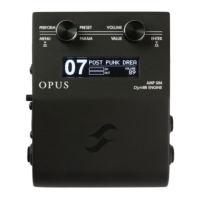2023/11/06 14:11 21/41 OPUS User's Manual
User's manuals - https://wiki.two-notes.com/
All Two notes Virtual Cabinets come with an individual collection of 8 microphones specifically
matched to the cabinet. You access the list of microphones by clicking the blue window above the mic
channel fader. For easy identification, microphones are described by their underlying technology:
DYN is a dynamic microphone, CND is a condenser microphone and RBN is a ribbon mic.
Within each Mic Channel, the following controls are available to refine your mic’ed cabinet’s tone:
Channel Fader - Use the fader to set the volume level of the related mic channel
FRONT / BACK - Use this switch to place the selected microphone in front or behind the cabinet
B - Use the “Bypass” (B) button to send an unprocessed signal though the mic channel
M - Use the Mute button (M) to mute the associated mic channel
Ø - Use the Phase button (Ø) to flip the phase of the selected microphone channel
DISTANCE - Use the DISTANCE knob to move your microphone forward and backwards within
the designated miking quadrant on the Torpedo Remote DynIR™ graphical user interface
AXIS - Use the AXIS knob to position the mic horizontally within the designated miking quadrant
on the Torpedo Remote DynIR™ graphical user interface
You can move the microphones
anywhere in the trapezoid highlighted
area as shown within the miking pane
of the Torpedo Remote DynIR™
graphical user interface. Select MIC A
or MIC B via the dedicated switch and
move the microphone with your mouse
(when using a computer) or your finger
(when using a mobile device) by
pressing on either the microphone
image or the associated mic stand.

